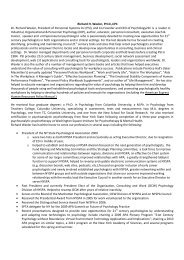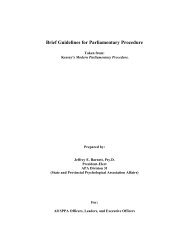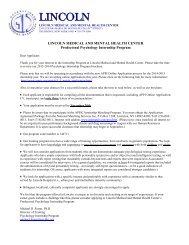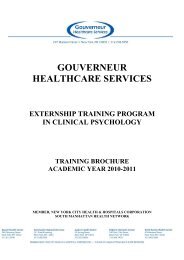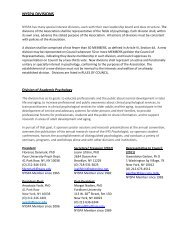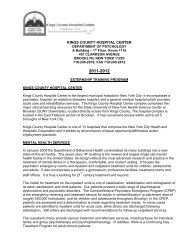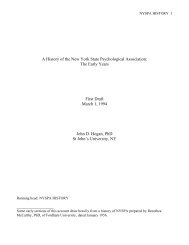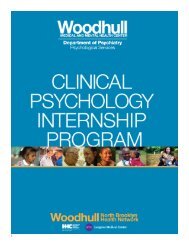2011 ⢠NYS Psychologist - New York State Psychological Association
2011 ⢠NYS Psychologist - New York State Psychological Association
2011 ⢠NYS Psychologist - New York State Psychological Association
You also want an ePaper? Increase the reach of your titles
YUMPU automatically turns print PDFs into web optimized ePapers that Google loves.
Addressing Intimate Partner Violence on College<br />
Campuses: Strategies and Opportunities<br />
Vanessa M. Bing, PhD<br />
LaGuardia Community College, City University of <strong>New</strong> <strong>York</strong><br />
Intimate partner violence (IPV) represents a pattern of coercive<br />
and abusive behavior in a relationship where one partner attempts<br />
to gain control over another intimate partner. Intimate partner<br />
violence largely affects women and is a global public health concern.<br />
College women are part of the national statistics, although<br />
less is known about this population as the phenomenon is largely<br />
under studied. The City University of <strong>New</strong> <strong>York</strong> has recently taken<br />
an important move in addressing the problem of intimate partner<br />
violence by passing a resolution for each of its campus school<br />
to develop a policy addressing intimate partner violence on campus.<br />
It is recommended that U.S. colleges and universities similarly<br />
take proactive measures to create structures, policies and<br />
procedures for addressing IPV and undertake research to understand<br />
the nature and scope of this problem on college campuses.<br />
Keywords: intimate partner violence, abuse, gender violence, college<br />
dating<br />
Intimate partner violence (hereinafter IPV) is broadly defined<br />
as violence occurring between persons who have a current or<br />
former dating, marital or co-habiting relationship, with someone of<br />
the same- or opposite-sex. Such violence, frequently referred to<br />
as domestic violence, can represent a pattern of coercive and<br />
abusive behavior in a relationship when one partner attempts to<br />
gain or maintain control over another intimate partner. This abuse<br />
can be physical, sexual, emotional, economic or psychological in<br />
nature. Even when there are no acts of physical violence, the<br />
threat of violence is present and abolishes one’s sense of safety<br />
and security in the relationship. Although men are also victims of<br />
partner abuse, findings from the Bureau of Justice Statistics’ National<br />
Crime Victimization Survey show women are at significantly<br />
greater risk of IPV (Tjaden and Thoennes, 2000). Indeed, the<br />
overwhelming majority of reported victims are women.<br />
In the United <strong>State</strong>s, violence against women is a significant<br />
problem. This violence perpetrated by intimates constitutes 20 -<br />
25% of violent crimes against women (Rennison, 2003; Tjaden<br />
and Thoennes, 2000). The highest rate of intimate partner violence<br />
occurs among women ages 16 – 24 (U.S. Department of<br />
Justice, 2003; 2009), and there are estimates that some 32% of<br />
college students are victims of intimate partner violence (Feminist<br />
Majority Foundation, 2005). However, girls as young as age 12<br />
have been counted among those victimized by intimates with females,<br />
aged 12 and older, reporting approximately 552,000 nonfatal<br />
violent victimizations (rape/sexual assault) by an intimate<br />
partner in 2008 (Catalano, Smith, Snyder & Rand, 2009). The<br />
Centers for Disease Control and National Institute of Justice report<br />
nearly 5 million incidents of IPV occurring each year among<br />
women 18 and older, and IPV results in nearly two million injuries<br />
and over 2000 deaths nationwide. Intimate partner violence or<br />
domestic violence in particular has become one of the most serious<br />
public health and criminal justice issues, with one of every<br />
four U.S. women being physically assaulted or raped by an intimate<br />
partner (Tjaden & Thoennes, 2000).<br />
The <strong>State</strong> of <strong>New</strong> <strong>York</strong> Office for the Prevention of Domestic<br />
Violence reports equally staggering numbers in their Domestic<br />
Violence Dashboard Project Data (2008) noting approximately<br />
450,000 domestic violence incidents are reported to police<br />
departments annually, and 50% of females aged 16 and older<br />
who were victims of homicide were killed by an intimate partner.<br />
Similarly, a report from the <strong>New</strong> <strong>York</strong> City Department of Health<br />
and Mental Hygiene (2008) supports these state and national<br />
statistics, citing nearly half of fatal violence against women to be a<br />
result of IPV. In 2005 alone, nearly 4,000 <strong>New</strong> <strong>York</strong> City women<br />
were treated in emergency departments for injuries due to intimate<br />
partner violence. Anonymous surveys conducted between<br />
2004 - 2005 revealed an estimated 69,000 <strong>New</strong> <strong>York</strong> City women<br />
aged 18 and older reported fearing an intimate partner; and 49%<br />
of women killed by an intimate partner had a prior domestic incident<br />
report in the system. These figures are compelling and paint<br />
a critical portrait of women being victimized in <strong>New</strong> <strong>York</strong> City as<br />
well as throughout the state. Students attending colleges in <strong>New</strong><br />
<strong>York</strong> City and <strong>New</strong> <strong>York</strong> <strong>State</strong> are part of these statistics. Yet,<br />
little attention is typically given to college students who experience<br />
these issues.<br />
Consequences and Effects of IPV<br />
Women who are victimized by their intimate partners face<br />
serious physical and psychological injuries, the costs of which<br />
cannot be adequately measured. These women suffer from a<br />
number of clinical syndromes including depression, generalized<br />
anxiety, and posttraumatic stress disorder (PTSD). Additionally,<br />
these women may experience a plethora of other conditions including<br />
chemical dependency, substance abuse, somatic and<br />
medical symptoms, negative health behaviors, and changes to<br />
health service utilization (World Health Organization, 2000). IPV<br />
victims may feel suicidal, homicidal and/or blame themselves for<br />
the abuse. Intimate partner violence is also repetitive, with twothirds<br />
of victims reporting multiple incidents of abuse by their intimate<br />
partner. In one survey, half of all women reported victimization<br />
by the same partner from two to nine times (Carr & Ward,<br />
2006). These repeated experiences of abuse may lead to a retraumatization<br />
of the victim and heightened PTSD or other stress<br />
responses.<br />
Relationship Violence and the College Student<br />
Much of the research on violence in college students has<br />
examined the problem of sexual violence, specifically rape and<br />
sexual assault (e.g. Belknap & Erez (1995), American College<br />
Health <strong>Association</strong> (2005)) finding that 15 - 25% of college women<br />
—————————————————————————————<br />
Dr. Vanessa Bing is a licensed clinical psychologist and an Associate<br />
Professor of Psychology in the Social Science Department at LaGuardia<br />
Community College of the City University of <strong>New</strong> <strong>York</strong>. She also holds the<br />
position of Faculty Mentor/Director of LaGuardia’s Women’s Center, and<br />
previously served as Director of the Women’s Center at Borough of Manhattan<br />
Community College, CUNY. As a licensed practitioner, Dr. Bing has<br />
worked in a variety of educational and clinical settings. Immediately prior<br />
to joining the faculty at LaGuardia, Dr. Bing was a supervising psychologist<br />
at the University Counseling Center at <strong>New</strong> <strong>York</strong> University where she<br />
was also a member of the adjunct faculty in the M.A. Counseling Program<br />
in the Department of Applied Psychology at the Steinhardt School. Dr.<br />
Bing has published a number of articles addressing minority and gender<br />
issues in psychology and clinical practice, and has lectured extensively on<br />
the issue of trauma and domestic violence. Dr. Bing’s current research<br />
interest focuses on the experience of intimate partner violence in women<br />
attending urban colleges, and the impact of partner violence on student<br />
retention.<br />
Page 25<br />
Vol. XXIII No. 2 • Fall <strong>2011</strong> • <strong>NYS</strong> <strong>Psychologist</strong>



